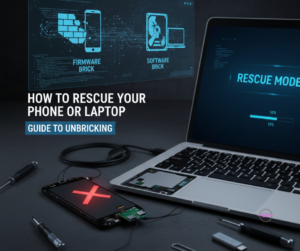
Technology is amazing — until it stops working. Imagine you’re updating your phone’s firmware or reinstalling your laptop’s operating system, and suddenly everything freezes. The screen goes black, it won’t power on, and you’re left with a sinking feeling that your device is “bricked.”
If this sounds familiar, don’t panic. In most cases, your phone or laptop isn’t truly dead — it just needs the right rescue process. At Smart Electronix, we’ve helped countless customers revive “dead” devices through advanced diagnostics, software repair, and data recovery.
Let’s break down what bricking really means, why it happens, and — most importantly — how to fix it.
What Does “Bricked” Really Mean?
A “bricked” device refers to a phone, tablet, or laptop that no longer functions because of corrupted firmware or damaged software. It’s called bricked because it’s as useful as a brick — at least temporarily.
There are two main types:
-
Soft Brick – The device powers on but can’t fully boot into the system. You might see a logo loop, an error message, or a frozen loading screen.
-
Hard Brick – The device doesn’t respond at all. No charging light, no logo, nothing. This often points to deep firmware corruption or hardware-level failure.
At Smart Electronix, most cases we see are soft bricks, which are usually recoverable with the right tools and technical expertise.
Why Devices Get Bricked
Bricking can happen for a number of reasons, including:
-
Interrupted Firmware Update – A power cut or disconnection during a system update.
-
Corrupt Software Installation – Installing the wrong or damaged firmware.
-
Rooting or Custom ROMs – Modifying system files without proper technical knowledge.
-
Overheating During Update – Device overheats mid-process, corrupting the software.
-
Failing Storage Chips or Hardware – In rare cases, physical faults in the device can trigger bricking symptoms.
Understanding the cause helps determine the right recovery approach.
How to Rescue a Bricked Phone
If your phone doesn’t boot properly, here are steps you can try before seeking professional help:
1. Force Restart
Hold down the power and volume buttons for about 10–15 seconds. This can sometimes reboot the system and resolve temporary crashes.
2. Check for Power
Connect your device to a reliable charger and let it sit for at least 20 minutes. Some phones show no sign of charging when the battery is completely drained.
3. Enter Recovery Mode
Most Android devices can access Recovery Mode (Power + Volume Up) or Fastboot Mode (Power + Volume Down). From there, you can try a factory reset or sideload official firmware.
For iPhones, entering Recovery or DFU Mode allows you to restore your device through iTunes or Finder.
4. Use Official Repair Tools
Many manufacturers, like Samsung, Xiaomi, and Huawei, offer official firmware tools that can reinstall system software safely. Always use the latest version from trusted sources.
5. Seek Professional Help
If your phone still shows no signs of life — no LED, no logo, no vibration — it’s time to consult a diagnostic repair expert. At Smart Electronix, our technicians can reprogram the firmware using advanced tools and restore your device without risking data loss.

How to Rescue a Bricked Laptop
Laptops can also suffer from firmware or BIOS corruption, especially after failed updates or malware attacks. Here’s what to do:
1. Perform a Power Reset
Disconnect the battery and charger, press and hold the power button for 30 seconds, then reconnect everything and power on. This clears static power issues.
2. Boot into Safe Mode or Recovery
If your laptop turns on but fails to load the OS, try booting into Safe Mode or using a bootable USB to repair system files.
3. BIOS/UEFI Recovery
Many laptops come with built-in BIOS recovery options. Follow your manufacturer’s guide for resetting the BIOS or restoring it from a USB.
4. Reinstall or Repair Windows/macOS
If system files are beyond repair, reinstalling the OS might be the cleanest option. Always back up data first, if possible.
5. Visit Smart Electronix for Advanced Diagnostics
If your laptop doesn’t power on at all or keeps rebooting, the issue could be at the motherboard or firmware level. Our laptop repair experts use advanced diagnostic equipment to pinpoint and fix these failures — often without needing to replace the board.
Preventing Future Bricks
Here’s how you can reduce the risk of bricking your device again:
✅ Keep your battery above 50% before performing updates.
✅ Avoid interrupting updates or flashing processes.
✅ Download firmware only from official or verified sources.
✅ Back up your data regularly using cloud or external storage.
✅ Get professional firmware updates if you’re unsure about the process.

When to Call the Experts
If your device shows no power, no display, or boot loops endlessly, don’t keep trying random fixes — it can make recovery harder.
At Smart Electronix, we specialize in:
-
Firmware Reflashing & Software Repair
-
Board-Level Diagnostics
-
Data Recovery from Non-Booting Devices
-
Hardware Replacement & Soldering Repairs
Our team can recover phones and laptops that other repair shops often consider “dead.” Whether you’re dealing with an Android, iPhone, MacBook, or Windows laptop — we’ve got you covered.
Final Thoughts
Bricking doesn’t always mean the end of your device — it’s often just a deep software problem waiting for the right fix. With the right recovery process and expert support, you can bring your device back to life and restore your valuable data.
If your phone or laptop is stuck on the logo, won’t boot, or appears completely dead, don’t lose hope — Smart Electronix can help. Bring your device to our Melbourne repair center, and our certified technicians will perform a full diagnostic check, repair your firmware or software, and get your tech running like new again.
